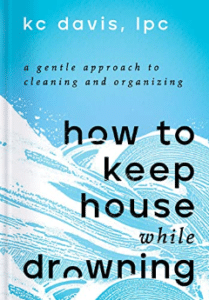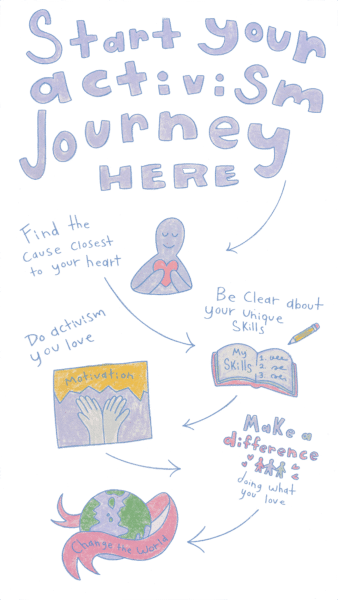- The Meaning of Critical Thinking: A Key Skill for Navigating Today’s Information Landscape - November 3, 2025
- Grandparents Can Develop Activist Grandchildren - September 29, 2025
- Top Six Reasons Credit Union Benefits Are a Smart Choice Over Banks - August 18, 2025
Last Updated on March 3, 2025

As I read this book, I realized these same lessons can help activists make a difference in the world even when they feel like they are drowning.
Many people I speak with about activism want to make a difference in the world but struggle to start because of issues in their life, such as not having enough time because of competing priorities. Even if they set a goal to make a difference, getting started in activism without guidance can be frustrating. Some new activists jump into activism without preparation, only to get overwhelmed or burnt out.
For example, in our book, Make a Difference With Mental Health Activism, Trish Lockard and I review the state of mental health in America. In the United States, one in five people has a mental health diagnosis. During the pandemic, that rose to 1 in 3 people. People are struggling, and that makes activism seem daunting.
If you are clear about the roles most important in your life, and ‘activist’ is one of them, there are ways to make a difference even if you are struggling.
Keeping House While Drowning Strategies
Davis is a therapist who recognized that many people struggle in caring for their house and sometimes prioritize that over their own self-care. She experienced her own struggles, including a difficult time with a newborn and toddler during the pandemic.
Key Points of the Book
Self-Compassion
Davis says you must give yourself the same kindness you would show another person. Self-compassion can help you overcome negative emotions such as guilt and shame. Once you discard these negative emotions, you can find ways to keep house that work for you and what you can do.
One example in Davis’s book is that she keeps her bedroom clean because it makes her feel calm. But she sacrifices the bathroom, which she describes as looking like a pack of animals got loose. Self-compassion means believing it is perfect for you and not allowing your situation to be a source of stress, guilt, or shame.
“As you embark on this journey, I invite you to remember these words: “slow,” “gentle,” “quiet.” You are already worthy of love and belonging. This is not a journey of weakness but a journey of care. A journey of learning how we can care for ourselves when we feel like drowning because you must know in your heart that you are worthy of care whether your house is immaculate or a mess.”
Speaking compassionately to yourself looks like viewing chores as a kindness to yourself rather than obligations. An essential way of being compassionate to yourself is to recognize that what you can do is perfect, even if your neighbor might feel you are not doing enough.
Housekeeping Strategies and Hacks
When you are feeling depressed, or your body isn’t working right, you can use strategies and hacks. Davis recommends taking deep breaths and saying compassionate words to yourself. Start doing chores for a short time, and sometimes you find you can do a little more. And if you can’t, be kind to yourself.
Use her 5-step process to manage the most critical chores—dishes, trash, and laundry.
- Gather trash in a bag.
- Gather dishes and put them in your sink or on your counter.
- Use a basket to gather laundry and shoes and place it next to the trash.
- Choose an area and put things away that have a place.
- Now take things that don’t belong and put them in a pile.
This process works because you can focus on one category at a time instead of looking at everything at once. That can be overwhelming.
How to Keep House While Drowning Applied to Activism

Sydney loved cats and wanted to adopt a kitten. But he would not do so because the kitten must eat meat to be healthy. As a vegan vehemently opposed to eating animals, Sydney could not justify providing meat to a cat. He seemed so sad about missing the chance to have the kitten in his life.
How can we use Davis’s recommendations for self-compassion, setting expectations, and using strategies and hacks in volunteering and activism?
Self-Compassion
I asked cat-lover Sydney about another person adopting the same kitten. Since the kitten is already born, someone will feed it meat. Isn’t it the same impact on the world whether he feeds the kitten or another person does? And I knew he would find great joy in the cat.
But he could not relax his values enough to justify adopting the kitten.
It was sad to see this remarkable young man, who is making a difference in the world, denying himself the grace he would give others.
Using Davis’s strategies, he could acknowledge the beautiful ways he has made a difference in the world and how rescuing a kitten might be a part of that. And most importantly, that he deserves to have joy in his life. I hope over time, he became more compassionate with himself.
Prioritize Self-Care
Activism can be hard sometimes, and staying motivated is essential. Activists may experience trauma or work with people who have been traumatized. You’ve probably heard the word burnout in the context of work. But it happens in activism, too. Burnout symptoms include fatigue, trouble concentrating, sadness, anxiety, and poor performance. Activists must recognize the potential effects of burnout and keep themselves emotionally healthy.
It can be hard to step back from your important work, but if you are experiencing burnout, you must. You might consider taking a break, devoting fewer hours, or trying a different way to make a difference.
Your activism must give you joy.
Davis says you must take care of yourself first. So basic self-care tasks must come before other activities.
“You can’t save the rainforest if you’re depressed. You are not responsible for saving the world if you are struggling to save yourself…Feeling shame for not being sustainable, for eating meat, or for purchasing fast fashion when you are fighting to get through the day is not going to make you magically gain the ability to do something different. Shame is a horrible long-term motivator. It is more likely to contribute to dysfunction and continued cycles of unsustainable practices.”
Social change movements involve many people doing many different things over time. Recognize that you are one part of this movement, and if you have to take a break or step back for a while, you can return to the movement when you can. The movement will continue, and self-compassion means you understand you should care for yourself first.
Change Expectations
Davis suggests managing your expectations of what you contribute—that you are not required to be productive to be worthy of love. What a powerful way to see how we are part of our family, community, and world.
“I want my kids to grow up and care for others and treat them fairly without being crushed by the false guilt of thinking their work is tied to how much they can produce or contribute. I want that for all of us.”
Suppose we translate this to volunteering and activism. In that case, it means prioritizing our work to serve our mental and physical health. Davis discusses how she lives her values and recommends a two-tier approach to volunteering and activism.
“The first tier lists the standards I expect myself to be accountable to at all times and in all areas of my life. This is also the tier I welcome anyone to hold me accountable for. For me, this tier includes ensuring my behavior is not racist, sexist, classist, homophobic, transphobic, or ableist, that I always refrain from abusing or exploiting others, and that I always act with honesty and integrity.
The second tier includes morally good things that aren’t absolutes but that I participate in when possible: supporting small businesses, donating money, volunteering my time, recycling, avoiding fast fashion, reducing waste, prioritizing businesses with ethical practices.”
This approach supports self-care and sets the expectation that you don’t always have to contribute to be worthy.
Staying Motivated in Activism

- Find your passion.
- Use your talents.
- Choose a method you love.
- Make an impact
- Stay motivated
As you travel the Activism Path, you reflect on your skills and match those to an activism technique that motivates you. You end up with activism you love, which is a personal fit for you.
Step 1: Focus Your Passion
Narrowing your activism focus helps you develop expertise and avoid getting overwhelmed. Find the cause closest to your heart.
Another exercise in Step 1 is examining the many roles you play. Humans cannot successfully play many roles, though; considering how to focus on the roles dearest to you will keep you satisfied. Create your list of roles and then narrow it to the five you believe are most worthy of your focus.
Step 2: Check your Personal Motivation
In Step 2 of the Activism Path, you inventory your gifts. One of those gifts is your personal motivation. You’ll be more satisfied by building your top motivator into your activism.
Identify what motivates you most:
- Working with others
- Translating your values into positive action
- Feeling capable and learning
- Satisfaction from the work itself
Step 3: Choose an Activism Method You Love
There are many methods you can use to make a difference. Choose one you enjoy, and you’ll increase the odds of staying motivated long-term. For example, if you enjoy organizing, use your skills in your favorite cause to manage volunteers or plan events. If you love writing, support your cause by penning letters to the editor. Leave the tasks you don’t enjoy to someone who does.
Step 4: Make an Impact
In this step, you find where you can apply your skills to the cause closest to your heart and make the most impact. But also in a way that matches the time you have available to devote to your cause. Knowing that you are making the most change possible will motivate you to continue.
Step 5: Stay Motivated
In Step 5 of the Activism Path, you create goals to set yourself up for success. Goals keep you focused and motivated.
Another exercise in Step 5 is understanding how your body reacts to stress. Coping strategies such as self-care help you deal with stress before it becomes overwhelming.
Activities that support your physical health
- Good sleep
- Healthy diet
- Relaxation
- Exercise (try a nature fix!)
Activities that support your mental health
- Set reasonable boundaries, such as saying ‘no’ to requests that add stress. Read more about how to use boundaries in activism.
- Have a ‘not-to-do’ list.
- Journal to support your mental health.
- Write down what you are grateful for.
Your activism may stress you to a degree you can’t control it with coping strategies. In that case, more intense stress reduction may be necessary.
Step Back and Refocus
If, despite using coping strategies, you cannot manage your stress, look for opportunities to step back. Taking a break is okay. Decide whether you need to refocus your activism efforts.
If you work with an activist organization, evaluate how well they meet your needs. Do they help you cope? Do they coach, mentor, and train you? Are you getting the right information and tools? Do they care about helping you meet your activism goals? One way to refocus is to negotiate changes in your work that will help you avoid stressful situations. If your organization is not meeting your needs, find one that does.
Or perhaps you need to make a significant change. If so, go back to the Activism Path Step 1 and see what other direction your passion takes you. Work the process so you are still using your skills and knowledge, are motivated, and are making the change you want in the world.
Being an activist means making a difference for others, but you must also nurture yourself. Use the Activism Path to set yourself up in activism that you love.
[Are you ready to live your ideal life? Here’s how.]
READ NEXT
How To Use a Compassion Fatigue Test to Battle Burnout
The Most Powerful Self-Care Strategy For Activists
Is Self-care Important? How Caring for Yourself Helps You and Others



